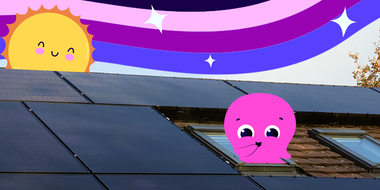How much can you save with solar?
Over 1.5 million homes in the UK now have solar panels installed and are busy soaking up the sunshine as we speak – so, is it time to join them? We think so.
With solar panels and a battery, you could save around 90% on your electricity bills with our Fixed Outgoing tariff or even make up to £300 profit a year with our Intelligent Octopus Flux tariff.
See what you could save straight away using our solar costs & savings calculator or read on below to see how solar savings work.

3 for 2 solar panels
Get up to 6 panels on us when you order a solar and battery system with a Fox EVO 10 kWh smart battery before 31st December 2025. T&Cs apply.
How solar savings work

When calculating how much you could save, there’s no-one-size-fits-all answer. It depends on:
- The size of your solar system – how many panels and what they can generate in kilowatts (kW).
- Whether you have a battery – to store energy and use it later.
- Your choice of tariff – some offer flat rates, others dynamic pricing (see our guide below).
- How you use electricity – when and how much you use.
We’ll now break down how each of these can impact your potential savings depending on whether you opt for a battery and what tariff you choose.
Pairing solar panels with a battery
Like twin flames, solar panels and home battery storage make the perfect pair. Here’s why:
- Store your free solar energy generated during the day to use when needed.
- Reduce bills by around 90% by using the electricity you generate.
- Buy cheap electricity when demand is low e.g. ~8.5p/kWh for EV charging overnight.
- Sell energy back to the grid at peak times (for higher rates ~22.37p / kWh on Intelligent Octopus Flux).
Customers on our Flexible Octopus + Outgoing Fixed tariffs save 91% on their electricity bills with a 5kWh battery – that's 16% more savings than customers without one!
What size battery should I choose?
It’s best to match the size of your battery size to your home's energy use. For most homes, a 5kWh battery will probably do the job nicely, but if you use more energy or you’re thinking about getting an EV or heat pump – a larger battery could be worth the investment.
Our solar specialists will recommend the perfect battery for your lifestyle when you get a quote with us. Check out our tech and the battery options available.
Our solar smart tariffs
Unlike standard tariffs with the same unit rate all day, our solar tariffs offer prices that change throughout the day and night which you can use to your advantage.
- Get cheaper, greener energy – typically at night, when there’s less demand and plenty of renewables.
- Sell your solar when it's super valuable – like dinnertime (4-7pm) when the grid needs it most.
- Help balance the grid – by putting clean energy in the system and reducing the need for fossil fuels.
Each of our tariffs is a little different – let's see which is best for you.

For each of the savings figures below, we've compared the typical installation cost and annual bill savings for our most common solar system (10 x 445W panels with a 5kWh battery). You can find our full savings breakdown at the end of this article.
1. Intelligent Octopus Flux
Potential savings: Up to 118% or £1,069 per year
✅ Best for: Maximum savings with minimal effort
✅ Import or export: Both
✅ How it works: We automatically charge your battery when energy is cheapest and greenest, then export when prices are highest
✅ Compatible with: Tesla or Enphase batteries
✅ Perfect if: You want to set it and forget it

2. Octopus Flux
Potential savings: Up to 96% or £864 per year
✅ Best for: People who like more control
✅ Import or export: Both
✅ How it works: Super cheap rates between 2am-5am to charge your battery, peak export rates from 4pm-7pm
✅ Compatible with: Any home battery
✅ Perfect if: You're happy to schedule your battery operation
Tip: How and when you use your electricity matters. If you shift your energy use to off-peak times you’ll maximise your savings on our Flux tariffs.
3. Outgoing Octopus
Potential savings: Up to 91% or £822 per year with a 5kWh battery, 75% or £682 without, when paired with our Flexible Octopus tariff
✅ Best for: Predictable export rates
✅ Import or export: Export only
✅ How it works: Fixed rate of 15p per kWh for every unit you export
✅ Perfect if: You prefer simplicity, don't have a battery or want to pair with a different import tariff
4. Outgoing Agile
Potential savings: Varies based on market conditions
✅ Best for: Energy enthusiasts who want to maximise potential gains
✅ How it works: Dynamic half-hourly pricing based on wholesale energy costs
✅ Perfect if: You enjoy actively managing your energy use

Smart Export Guarantee (SEG)
If you’d prefer to go with another supplier for your import energy, you can still join our standard Smart Export Guarantee tariff, but you won’t find the rates as competitive as our smart tariffs.
Which tariff is right for you?
Not sure which tariff would suit you best? Take our quick smart tariff quiz to find your perfect match.
Remember, you'll need a smart meter to take advantage of any Octopus smart tariffs.
Payback period: When will my solar system pay for itself?
By saving on your electricity bills and making money on export payments, your solar system will begin to pay for itself. How long it takes will depend on the number of solar panels you have and the amount of energy you use.
We compared a medium-usage household with different panel, battery and tariff combinations and found that the payback period was between 9-10 years, based on October 2025 tariff rates. These calculations assume a 4% increase in energy cost each year, based on the increase seen over the past 10 years.
We’ll share a more accurate payback period, as well as your generation estimates and monthly savings, during your free design consultation where we design your perfect solar setup. To get the ball rolling, get a quote and we’ll be in touch.
Ready to see your solar savings?
Every home is different so it’s best to get a personalised breakdown of costs and potential savings. Get a quote and we'll help you find the perfect solar solution for your home and lifestyle.
Interested in our workings? Here’s the full breakdown:
Check out the full cost comparison below for average savings (based on the Ofgem average for a medium sized UK home and October 2025 prices):
| A | B | C | D | E | F | G | H | I | J | K | |
|---|---|---|---|---|---|---|---|---|---|---|---|
| System & tariff | Total elec usage | Total generation | % self usage | Import rate | Standing charge | Export rate | Total annual elec bill | Total elec bill saving (£) | % Saving | Installation cost (£) | Payback period |
| No solar (elec only) | |||||||||||
| Flexible Octopus | 2,700 kWh | - | - | 26.35 p/kWh | 52.72 kWh/day | - | £904 | - | - | - | - |
| 10 panel solar, no battery | |||||||||||
| Flexible Octopus + Fixed Outgoing | 2,700 kWh | 4,000 kWh | 18% | 26.35 p/kWh | 52.72 kWh/day | 15 p/kWh | £222 | £682 | 75% | £7,649 | 10 |
| 10 panel solar, 5 kWh battery | |||||||||||
| Flexible Octopus + Fixed Outgoing | 2,700 kWh | 4,000 kWh | 49% | 26.35 p/kWh | 52.72 kWh/day | 15 p/kWh | £81 | £822 | 91% | £8,477 | 9 |
| Octopus Flux | 2,700 kWh | 4,000 kWh | 49% | 20.88 p/kWh | 52.66 kWh/day | 15.05 p/kWh | £40 | £864 | 96% | £8,477 | 9 |
| Intelligent Octopus Flux | 2,700 kWh | 4,100 kWh | 49% | 22.75 p/kWh | 52.66 kWh/day | 24.60 p/kWh | -£165 | £1,069 | 118% | £10,193 | 9 |
| 10 panel solar, 10 kWh battery | |||||||||||
| Intelligent Octopus Flux | 2,700 kWh | 4,100 kWh | 56% | 22.61 p/kWh | 52.66 kWh/day | 27.59 p/kWh | -£214 | £1,118 | 124% | £12,215 | 10 |
| 10 panel solar, 13.5 kWh battery | |||||||||||
| Intelligent Octopus Flux | 2,700 kWh | 4,100 kWh | 57% | 22.60 p/kWh | 52.66 kWh/day | 29.83 p/kWh | -£252 | £1,156 | 128% | £12,924 | 10 |
How we calculated the total savings
Save around 90% on electricity bills with solar & battery power
This is the electricity bill saving for a medium use home, with a 10 panel and 5kWh battery system on a standard tariff with our fixed outgoing rate (£81), compared to no solar installation on a Standard tariff (£904). This is a saving of £823 or 91% of their total electricity bill.
Here is an example calculation for a medium use home, with a 10 panel and 5kWh battery system running on a Standard tariff with a fixed outgoing rate, compared to no solar installation on a Standard tariff.
Standard Electricity Bill, G1 = A1*D1/100 + E1*365/100
Solar Electricity Bill, G2 = (A2- B2*C2)D2/100 - (B2-B2*C2)*F2/100 + E2*365/100
* Self consumption cannot exceed 90% of electricity usage, as per MCS standard
Electricity Bill Saving (£), H = G1 - G2
Electricity Bill Saving (%), I = G1/H2
Payback Period = J/H*
* Taking into account 4% annual energy price inflation based on ONS average for past 10 years as of May 2025 and 0.5% annual solar performance degradation
Where A - J are:
A1/A2 - 2,700kWh Ofgem medium household usage
B2 - 4,000kWh generation for 10 panel system*
* Based on 400kWh typical yield per panel on a 30 degree roof in SW London
C2 - 49% self consumption from MCS ‘in half the day’ look up tables
D1/D2 - 26.35p/kWh average Flexible Octopus electricity import rate (1st Oct 2025)
E1/E2- 52.72 p/kWh average Flexible Octopus electricity standing charge (1st Oct 2025)
F2 - 15p/kWh average Fixed Outgoing Octopus electricity export rate (1st Oct 2025)
J - Octopus Solar Installation costs (1st Oct 2025)
Check out our savings blog for other scenarios
Customers can even make up to £300 profit a year with Intelligent Octopus Flux
Between June 2024 and May 2025, the top 12% of Intelligent Octopus Flux customers paid less for the energy they imported than they earned for exporting their solar energy back to the grid. They offset their full electricity bill and standing charge and made £314 or more profit on top.
Discover more on solar

Looking to find out more? Find answers here.

Find out more about battery installation options with Octopus
Published on 26th April 2024 by:
Hey I'm Constantine, welcome to Octopus Energy!
×Close window

